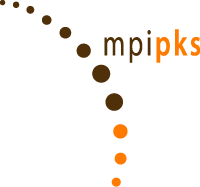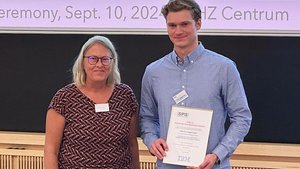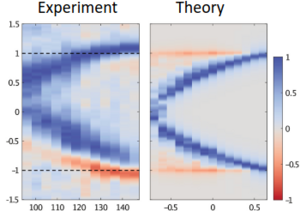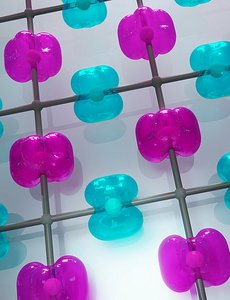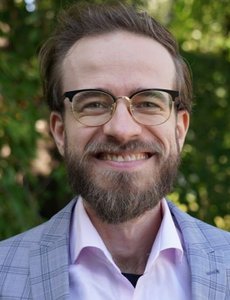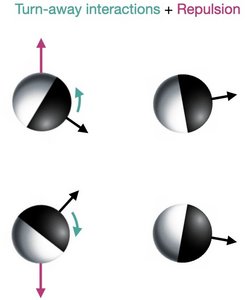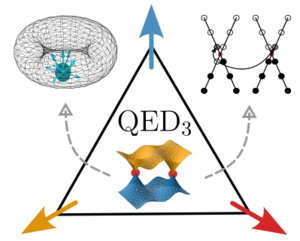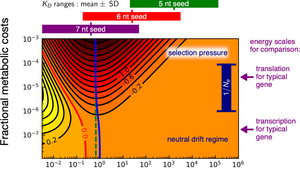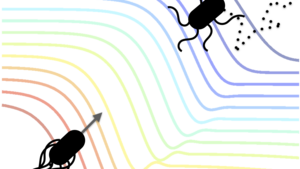
Highlights
Awards and Honors
Patrick Lenggenhager receives SPS thesis award
Every year, the Swiss Physical Society (SPS) awards a few young physicists for outstanding research work during their doctoral studies. This year, Patrick Lenggenhager, who joined MPI-PKS last year as a postdoc, is the recipient of the SPS award for condensed matter physics. In his doctoral thesis, Patrick explored multigap topology and hyperbolic lattices, two emerging avenues in band theory that are tied together by the overarching concepts of symmetry and topology. His findings advance the state of the art in these two key frontiers and underscore the centrality of band theory as a tool to uncover novel physical phenomena. We would like to congratulate Patrick on this impressive achievement and celebrate his contributions to condensed matter physics, which are sure to grow even larger in the coming years!
Read morePublication Highlights
Lifting the Veil of Topological Censorship
Topological protection provides unprecedented robustness of physical phenomena against all kinds of perturbations; but in doing so, it exercises topological censorship by hiding all kinds of interesting and important microscopic information. Recent experiments have collected microscopic information precisely of the kind hidden by such Topological Censorship. The work by Douçot, Kovrizhin and Moessner provides a detailed microscopic theory which goes beyond such topological censorship. It not only identifies an unexpected phenomenon – the meandering edge state carrying topologically quantised current – at variance with common expectations; but also identifies mechanisms which allow for tuning between qualitatively different microscopic implementations corresponding to one and the same topologically protected global quantity.
More details can be found in the press release (PDF).
Benoit Douçot, Dmitry Kovrizhin, and Roderich Moessner, Proc. Natl. Acad. Sci. USA, 121, e2410703121 (2024)
Read moreMore details can be found in the press release (PDF).
Benoit Douçot, Dmitry Kovrizhin, and Roderich Moessner, Proc. Natl. Acad. Sci. USA, 121, e2410703121 (2024)
Awards and Honors
Libor Šmejkal receives ERC starting grant
The European Research Council (ERC) has announced prestigious starting grants to researchers to set up their own teams and conduct research on the topics of their choice. One of these researchers is Libor Smejkal, a new group leader at MPI-PKS & MPI-CPfS, with his successful proposal on "Magnetic counterparts of unconventional superconductors for spin-conserved and non-dissipative electronics". The project will explore topological and quantum variants of unconventional magnets that are analogues to unconventional superfluids and superconductors. Libor's group will also search for realistic material candidates enabling low-dissipation electronics based on the unconventional magnetism. Congratulations!!
Read moreInstitute's News
New group at the institute: Functional Quantum Matter
We cordially welcome Libor Šmejkal as a new group leader at the institute! Libor joins us from the University of Mainz and establishes the Functional Quantum Matter group at MPI-PKS jointly with MPI-CPfS. The group studies complex quantum solid-state systems, focusing on unconventional magnets such as altermagnets, and topological materials. Libor and his team investigate these systems by developing analytical and computational tools based on symmetry and ab initio electronic structure theory. The aim is to achieve fundamental theoretical but experimentally testable scientific advances with potential functionalities in future energy-efficient, sustainable, and ultra-scalable nanoelectronics and spintronics. Welcome Libor!
Read morePublication Highlights
Moving together despite turning away
Self-propelled agents such as birds, cells, and active colloidal particles often move collectively in flocks. In the paradigmatic Vicsek model, flocking emerges due to alignment interactions between the active agents, which align much in the same way as spins do. Suchismita Das, Matteo Ciarchi, Ricard Alert of the Max Planck Institute for the Physics of Complex Systems and their collaborators have now discovered that flocking can emerge even if the agents turn away from each other.
The researchers made this surprising discovery in experiments with self-propelled colloidal particles that repel more strongly in their front half than in their rear half, in such a way that they turn away from each other. They then used simulations and two types of kinetic theory to explain how these particles end up flocking. Their theory revealed that repulsion between the particles is key: When two particles interact, repulsion pushes them apart before they can turn away too much, thus producing effective alignment, as shown in the figure. This crucial role of repulsion is surprising as repulsion is not even an ingredient in the paradigmatic models of flocking, such as the Vicsek model, where collective motion emerges just from alignment interactions between particle orientations. The new work also showed that, via repulsion, the particles can form flocking crystals, which are active counterparts of Wigner crystals formed through electrostatic repulsion in electron gases.
In conclusion, these active particles move in the same direction as a compromise between turning away from left and right neighbors. This mechanism of flocking could potentially be relevant for certain cells, which also turn away from each other upon collision via a process known as contact inhibition of locomotion. Whether these findings can explain how cells flock remains an open question for future work.
Suchismita Das, Matteo Ciarchi, Ziqi Zhou, Jing Yan, Jie Zhang, and Ricard Alert, Phys. Rev. X 14, 031008 (2024)
Read moreThe researchers made this surprising discovery in experiments with self-propelled colloidal particles that repel more strongly in their front half than in their rear half, in such a way that they turn away from each other. They then used simulations and two types of kinetic theory to explain how these particles end up flocking. Their theory revealed that repulsion between the particles is key: When two particles interact, repulsion pushes them apart before they can turn away too much, thus producing effective alignment, as shown in the figure. This crucial role of repulsion is surprising as repulsion is not even an ingredient in the paradigmatic models of flocking, such as the Vicsek model, where collective motion emerges just from alignment interactions between particle orientations. The new work also showed that, via repulsion, the particles can form flocking crystals, which are active counterparts of Wigner crystals formed through electrostatic repulsion in electron gases.
In conclusion, these active particles move in the same direction as a compromise between turning away from left and right neighbors. This mechanism of flocking could potentially be relevant for certain cells, which also turn away from each other upon collision via a process known as contact inhibition of locomotion. Whether these findings can explain how cells flock remains an open question for future work.
Suchismita Das, Matteo Ciarchi, Ziqi Zhou, Jing Yan, Jie Zhang, and Ricard Alert, Phys. Rev. X 14, 031008 (2024)
Awards and Honors
Prof. Matthieu Wyart awarded the "Physik Preis Dresden 2024"
On 18 June 2024, the French physicist Prof. Matthieu Wyart (EPFL, École Polytechnique Fédérale de Lausanne) was awarded the Physik Preis Dresden 2024. The theoretical physicist is being honoured for his pioneering contributions to various problems of complex systems, in particular the theory of financial markets, the physics of disordered and glassy systems as well as the theory of neural networks and machine learning. The Physik Preis Dresden is awarded annually jointly by the Dresden University of Technology and the Max Planck Institute for the Physics of Complex Systems (MPI-PKS).
Matthieu Wyart completed his PhD in Paris in 2005, where he worked together with J.-P. Bouchaud. During this time, he developed a model of price response functions in electronic markets, which became a standard in the industry. In the field of physics of disordered systems, he made an important breakthrough very early on by explaining how the surplus of soft modes in closely-packed systems of particles is controlled by their disordered geometry. This work elegantly solved the long-standing problem of the origin of the so-called boson peak in glasses with repulsive interactions. As a postdoc, he moved to Harvard and then Princeton before becoming an assistant and associate professor at New York University. He has been a professor at EPF Lausanne since 2015.
In recent years, Matthieu Wyart's original approaches and way of reasoning have had a strong impact and brought new insights into the physics of disordered systems. More recently, he has made significant contributions to the problem of the nature of the glass transition. In particular, his work suggests that increasing local energy barriers control the slowing down of dynamics in supercooled liquids, as opposed to co-operative effects.
The numerous original approaches to solving problems in different fields and disciplines are testimony to his extraordinary scientific excellence. In recognition of his outstanding contributions to the physics of complex and disordered systems, the Dean of the Faculty of Physics at Dresden University of Technology, Prof. Gesche Pospiech, together with Prof. Frank Jülicher, Director at the MPI-PKS, awarded the Physik Preis Dresden 2024 to Matthieu Wyart on 18 June 2024 as part of the Physics Colloquium.
The Physik Preis Dresden, endowed with 5,000 euros, was founded in 2015 by the Dresden physicist Prof Peter Fulde (1936-2024), the founding director of the MPI-PKS, and has been awarded annually to renowned scientists since 2017. The award winners are selected by a joint commission of the Dresden University of Technology and the MPI-PKS. In addition to the central criterion of scientific excellence, it is particularly important for the decision that the work of the award winners is of particular importance for the cooperation between the two DRESDEN-concept partners MPI-PKS and TUD and that their connection has been further strengthened in the long term.
Read morePublication Highlights
Quantum skyrmion Hall effect
The framework of the quantum Hall effect has been extended to a framework of a quantum skyrmion Hall effect by Ashley Cook of the Max Planck Institute for the Physics of Complex Systems and the Max Planck Institute for Chemical Physics of Solids, by generalizing the notion of a particle to include compactified p-dimensional charged objects. This is consistent with three sets of topologically non-trivial phases of matter previously discovered by Cook and collaborators: the topological skyrmion phases of matter, the multiplicative topological phases of matter, and the finite-size topological phases of matter. These findings indicate that topological states of D-dimensions can persist after compactification and yield previously unidentified generalizations of particles, a finding of relevance to many areas of physics, and particularly string theory, with great potential for rapid experimental confirmation.
Ashley Cook, Phys. Rev. B 109, 155123 (2024)
Read moreAshley Cook, Phys. Rev. B 109, 155123 (2024)
Publication Highlights
Quantum Electrodynamics in 2+1 Dimensions as the Organising Principle of a Triangular Lattice Antiferromagnet
Quantum electrodynamics (QED) is the fundamental theory that describes the interactions between electrons and photons. Its success has led some to wonder whether quantum field theories, like QED, can describe quasiparticles in a solid. These collective excitations include phonons, which describe lattice vibrations, and magnons, which are waves in a magnetic material, but might also be of a more exotic nature. In a recent study, Alexander Wietek of the Max Planck Institute for the Physics of Complex Systems and his collaborators show that QED in two spatial dimensions can be observed in frustrated antiferromagnets.
An antiferromagnet is a material in which neighbouring electron spins in the crystal lattice would like to point in opposite directions. However, in certain geometries, such as a triangular lattice, it is impossible to have all neighbouring spins align in precisely the opposite way. This is called geometric frustration and can lead to strong disorder in the system. This disorder is not featureless, however. In fact, it is shown that the quasiparticles of such a spin soup, known as a quantum spin liquid, are related one-to-one to excitations of QED. Importantly, even the elusive magnetic monopoles, among a wide variety of other particle-hole excitations, are observed.
The precise understanding of the spin-liquid state with magnetic monopoles as elementary excitations is a key step to discovering these exotic quasiparticles in antiferromagnetic materials. It is unlikely that the founders of QED would have predicted such a surprising emergence in condensed matter.
Alexander Wietek, Sylvain Capponi, and Andreas M. Läuchli, Phys. Rev. X 14, 021010 (2024)
Selected for a Viewpoint in Physics.
Read moreAn antiferromagnet is a material in which neighbouring electron spins in the crystal lattice would like to point in opposite directions. However, in certain geometries, such as a triangular lattice, it is impossible to have all neighbouring spins align in precisely the opposite way. This is called geometric frustration and can lead to strong disorder in the system. This disorder is not featureless, however. In fact, it is shown that the quasiparticles of such a spin soup, known as a quantum spin liquid, are related one-to-one to excitations of QED. Importantly, even the elusive magnetic monopoles, among a wide variety of other particle-hole excitations, are observed.
The precise understanding of the spin-liquid state with magnetic monopoles as elementary excitations is a key step to discovering these exotic quasiparticles in antiferromagnetic materials. It is unlikely that the founders of QED would have predicted such a surprising emergence in condensed matter.
Alexander Wietek, Sylvain Capponi, and Andreas M. Läuchli, Phys. Rev. X 14, 021010 (2024)
Selected for a Viewpoint in Physics.
Publication Highlights
Bioenergetic costs and the evolution of noise regulation by microRNAs
MicroRNAs (miRNAs) are short strands of genetic material that regulate various cellular functions and developmental processes. One of the regulatory functions of miRNAs is noise control that confers robustness in gene expression. The interaction with their target messenger RNA (mRNA) requires a specific binding sequence of 6-8 nucleotide pairs in length. There are a variety of open questions about the evolution of miRNA regulation regarding their functional efficiency and binding specificity.
Efe Ilker of the Max Planck Institute for the Physics of Complex Systems and Michael Hinczewski (Case Western Reserve University) show that this regulation incurs a steep energetic price, so that natural selection may have driven such systems towards greater energy efficiency. This involves tuning the interaction strength between miRNAs and their target messenger RNAs, which is controlled by the length of a miRNA seed region that pairs with a complementary region on the target. They show for the first time that microRNAs lie in an evolutionary sweet spot that may explain why 7 nucleotide pair interactions are prevalent: sequences that are much longer or shorter would not have the right binding properties to reduce noise optimally. To achieve this, they develop a stochastic model of miRNA noise regulation, coupled with a detailed analysis of the associated metabolic costs and binding free energies for a wide range of miRNA seeds. Moreover, the behaviour of the optimal miRNA network mimicks the best possible linear noise filter, a classic concept in engineered communication systems. These results illustrate how selective pressure toward metabolic efficiency has potentially shaped a crucial regulatory pathway in eukaryotes.
Efe Ilker and Michael Hinczewski, Proc. Natl. Acad. Sci. USA 121, e2308796121 (2024)
Read moreEfe Ilker of the Max Planck Institute for the Physics of Complex Systems and Michael Hinczewski (Case Western Reserve University) show that this regulation incurs a steep energetic price, so that natural selection may have driven such systems towards greater energy efficiency. This involves tuning the interaction strength between miRNAs and their target messenger RNAs, which is controlled by the length of a miRNA seed region that pairs with a complementary region on the target. They show for the first time that microRNAs lie in an evolutionary sweet spot that may explain why 7 nucleotide pair interactions are prevalent: sequences that are much longer or shorter would not have the right binding properties to reduce noise optimally. To achieve this, they develop a stochastic model of miRNA noise regulation, coupled with a detailed analysis of the associated metabolic costs and binding free energies for a wide range of miRNA seeds. Moreover, the behaviour of the optimal miRNA network mimicks the best possible linear noise filter, a classic concept in engineered communication systems. These results illustrate how selective pressure toward metabolic efficiency has potentially shaped a crucial regulatory pathway in eukaryotes.
Efe Ilker and Michael Hinczewski, Proc. Natl. Acad. Sci. USA 121, e2308796121 (2024)
Publication Highlights
Characterising the gait of swimming microorganisms
The survival strategies of Escherichia Coli are controlled by their run-and-tumble "gait". While much is known about the molecular mechanisms of the bacterial motor, quantifying the motion of these microorganisms in three dimensions has remained challenging. Christina Kurzthaler of the Max Planck Institute for the Physics of Complex Systems and her collaborators have now proposed a high-throughput method, using differential dynamic microscopy and a renewal theory, for measuring the run-and-tumble behavior of a population of E. Coli cells. Besides providing a full spatiotemporal characterisation of their swimming gait, this new method allowed relating, for the first time, molecular properties of the motor to the dynamics of engineered E. coli cells. It therefore lays the foundation for future studies on gait-related phenomena in different microorganisms and has the potential of becoming a standard tool for rapidly determining motility parameters of swimming cells.
More details can be found in a press release (PDF).
C. Kurzthaler*, Y. Zhao*, N. Zhou, J. Schwarz-Linek, C. Devailly, J. Arlt, J.-D. Huang, W. C. K. Poon, T. Franosch, J. Tailleur, and V. A. Martinez, Phys. Rev. Lett. 132, 038302 (2024)
Y. Zhao*, C. Kurzthaler*, N. Zhou, J. Schwarz-Linek, C. Devailly, J. Arlt, J.-D. Huang, W. C. K. Poon, T. Franosch, V. A. Martinez, and J. Tailleur, Phys. Rev. E 109, 014612 (2024)
Selected for a Synposis in Physics.
Read moreMore details can be found in a press release (PDF).
C. Kurzthaler*, Y. Zhao*, N. Zhou, J. Schwarz-Linek, C. Devailly, J. Arlt, J.-D. Huang, W. C. K. Poon, T. Franosch, J. Tailleur, and V. A. Martinez, Phys. Rev. Lett. 132, 038302 (2024)
Y. Zhao*, C. Kurzthaler*, N. Zhou, J. Schwarz-Linek, C. Devailly, J. Arlt, J.-D. Huang, W. C. K. Poon, T. Franosch, V. A. Martinez, and J. Tailleur, Phys. Rev. E 109, 014612 (2024)
Selected for a Synposis in Physics.
